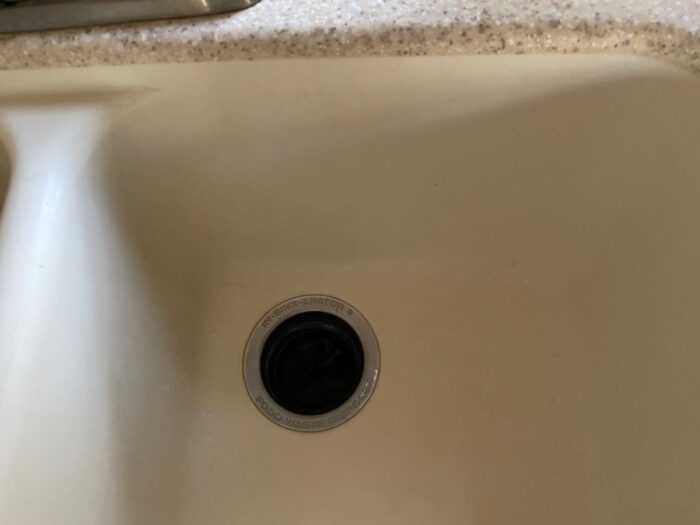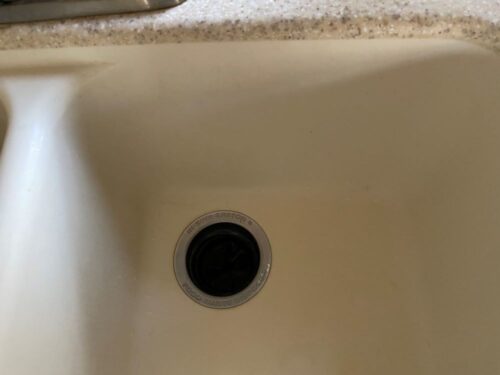A humming garbage disposal is not a relaxing sound. If fact, the humming usually means that something is not right and needs to be attended to quickly. Garbage disposals tend to be one of those appliances we take for granted to make life a little more comfortable.
But like most mechanical equipment, garbage disposals can wear out, or quit working for a number of reasons. Here are some of the causes of a humming disposal, what may be causing the hum–which is usually accompanied by the unit not working–and how to get it fixed.

8 Reasons a Garbage Disposal Hums
Almost all garbage disposals have a quiet hum when you turn them on. This is the sound of the motor working before anything is sent down the chute. This is a completely normal sound for completely normal operation.
Loud humming with no production is a different thing.
1) Garbage Disposal Jammed
Probably the most common cause of a humming garbage disposal is jammed blades. By bones, cutlery, build-up of residue, or too much of the wrong refuse dumped in at once. The hum you hear is the motor trying to turn the blades. If it tries to run while jambed for too long, you can burn out the motor.
- Turn the machine off, and unplug it.
- Get a flashlight to enable you to see down the drain.
- Remove everything in the drain with tongs or something that is not flesh. Yes, we know you turned it off. And unplugged it. But a little extra care does not hurt.
- Plug the unit back in and turn it on to see if you have solved the problem.
Turning it off and on a bunch of times is not necessarily the best option. This procedure will only make the jamb tighter.
2) Garbage Disposal Clogged
No, a clogged disposal is not the same as a jammed disposal. A clog is usually further down the line than the disposal blades. Clogs are caused by a build-up of ground material in the pipe leading to the drain or in the P-trap. The residue usually remains in the system because of lack of water pressure while the disposal is doing its job.
You can use a plunger on the garbage disposal to either drive the clog through or break it up and pull it back. Make sure you seal off the other drain (if there is one) or you will just be pumping air from one drain to the other, without accomplishing much.
If the plunger doesn’t work, you will have to remove the P-trap and/or connecting pipe to clean the system more thoroughly.
Some clogs are right where the blades and grinding plate is located. Before pulling off the P-trap and connecting pipe, use the mechanical option below.
3) Rusted Grinding Plates
The better garbage disposals are made with stainless steel grinding plates. Less expensive disposals can be made with ordinary steel plates. Or cheap stainless steel that will see the plating wear off over time.
When you have your flashlight out checking for the reason your machine is clogged or jammed, take a close look at the plates. If you see rust you may have to get it going again using the following method of breaking things loose.
Not only does rust pit and damage a piece of steel. it can bond 2 pieces of steel together. Meaning, in this case, that they might not turn. Not because of jams or clogs, but because the disposal has been idle long enough to allow parts to rust together. In most cases, the motor will break things apart and the machine will work normally. Sometimes it will need a little manual help.
If the rusting becomes too much of a problem, give some consideration to replacing the machine. Enough rust can start damaging things in there.
4) Mechanically Clear Jams or Clogs
Most garbage disposals are equipped with a breaker socket located in the bottom center of the unit. Many disposals also come with an Allen wrench made to fit the socket–usually 1/4″. Insert the Allen wrench into the socket and turn it back and forth. It is made to rotate both clockwise and counter clockwise.
What you are doing is rotating the fly wheel and grinding plate. This works the grinding plate against the blades to loosen debris and built-up grease. If you loosen up some debris, a pair of tongs will come in handy to clean it out.
When it feels like you have the blades loosened up, press the reset switch. (The reset switch might have kicked off when the disposal jammed or clogged.) Plug the disposal in and turn it on. If it is working, run some hot water through the machine for a few minutes. This one of the few times you should use hot water in your garbage disposal. If grease was part of the clog, the hot water will help turn it back to a liquid and flush it out.
Note: Always turn off and unplug the garbage disposal before working on it. This tends to prevent shocks, damage to the machine, and blade-shortened fingers.
5) Garbage Disposal Reset
Virtually all garbage disposals are equipped with a reset switch. It is a red button usually found on the bottom of the cannister. Reset switches are a safety device made to turn off the power in case of overheating, jambed disposal, or clogs.
Reset switches will usually be protruding from the bottom of the cannister if they have been tripped. They have a nasty habit of tripping at about the same time that you turn the unit off. Meaning that you may turn the machine back on and nothing happens. In that case, turn it off again and check that the reset switch has not turned the machine off also. Pushing the reset button when it has not tripped will not harm it.
Reset switches can wear out, break, or get weaker over time. Weaker switches tend to kick off easier. You may also find that the reset button will not stay retracted if there is still a jamb or clog that is preventing movement. In that case, you will need to use the 1/4″ Allen wrench to rotate the flywheel and grinding plate manually to free up the machine. (See #3) above)
6) Electrical Problem
If you do not hear a gentle start up hum and the disposal does not work at all even after using the reset, you may have an electrical problem. Electrical issues are not common on machines that have been in place for a while. But, as with any electrical power device, wires can get burned, and/or switches and breakers can wear out.
Any of these problems can happen in the machine, with the plug, on breaker panel. Newer GFCI receptacles have a small green LED light that glows to let you know they are working. If yours does not have a light, get another small appliance that you know is working and try it in the plug. Make sure the breaker is on.
If you have power to the plug, at least you know the problem is with the disposal. It might be electrical connections inside, it might be a burned out reset switch, or it might be a burned out garbage disposal.
Quite often electrical problems will appear at the time of installation or soon after. Loose wires. Not enough power in the circuit. Faulty machine, plug, switch, or wiring.
7) Garbage Disposal is Overheating
Garbage disposals can make humming sounds when they are overheating. Generally, overheating is caused by extended use of the disposal or forcing garbage through it. Quite likely you will hear the hum, then you will hear nothing as the heat build-up trips one of the safety breakers in the line. The reset on the machine. The GFCI plug breaker (if there is one). Or the breaker in the fuse box.
If it quits, turn it off and let it cool down for at least 5 minutes. If there is garbage in the disposal, remove as much as you can before turning it back on. This reduces the load on the machine. Press the reset switch (usually on the bottom of the disposal). Then turn the machine back on. If it does not restart, or the reset switch pops out again, let it cool down for a few more minutes.
Try the reset switch again and check the GFCI reset switch and the breaker box. If everything is switched on, the disposal should re-start after a 15 minute cool down. If it does not turn on, you may have burned it out.
Note: Do not press the reset switch without turning the machine off. Starting it with the reset switch is an excellent way of doing some permanent damage.
8) Worn Out Garbage Disposal
If you have tried everything else to get the garbage disposal to work, it just may be time for a new one. Good garbage disposals should last 15 plus years. Midrange disposals about 10 years.
If your machine is getting to that age, and you can’t get it to work, you are probably better to consider getting a new one. Having a plumbing professional come to fix your existing disposal will probably cost more than a descent new unit.
A new garbage disposal will cost between $70.00 and $300.00. That is a wide price range, but there are also many variables such as:
- Construction. Aluminum or stainless steel. Aluminum bodied disposals are less expensive, but more prone to leaking and corroding.
- Power. Standard power for disposals are 1/3 HP, 1/2HP, 3/4 HP, and 1 HP. The more power, the higher the cost.
- Feed Method. Garbage disposals are available with two types of feeding methods. Continuous feed units are more common and less expensive. Batch feeds cost more.
The prices do not include labor. Replacing a garbage disposal unit is not very difficult. You are just taking one out and putting in a new one. A whole new installation will probably require both new plumbing and electrical. If you do not feel up to this, call a plumber for a quote.
How to Keep Your Garbage Disposal Working
Extending the life of your garbage disposal while making it smell clean and fresh is not difficult. It just needs a little time and a little consistency.
What Not to Put into the Disposal
When in doubt, follow the manufacturers recommendations. This is only a partial list of what not to put down a garbage disposal, and why.
- Your Hand. Obvious.
- Any Kind of Grease. Coats and gums up blades–slowing them down.
- Bones. Dull blades, hard to grind, and can jamb disposal,
- Egg Shells. Can slowly dull blades and small pieces can eventually jamb machine.
- Coffee Grounds. Can cause blockages in the drainage system, and slow blades.
- Potato Peels. Potato peels can eventually turn into a glue-like mess that can jamb blades.
- Banana Peels and Celery. Tough, stringy skins that are difficult to grind and can wrap around the blades.
And many other things like metal, glass, seafood shells, fruit pits, etc.
Garbage Disposal Maintenance
The disposal looks like a fully self-contained unit, and for the most part it is–not requiring oil, grease, or other mechanical maintenance. But there are a few inexpensive, quick things you can do to prolong blade and machine life.
- Cold Water. Run only cold water into the garbage disposal when it is operating and for a few seconds after to clean the system.
- Ice. Run a handful of ice through the unit every week or two. This will help knock off residue and may even help sharpen the blades.
- Cleaner. For even better cleaning, mix vinegar, lemon juice, baking soda, or dish soap in with the ice for a cleaner and better smelling garbage disposal.

